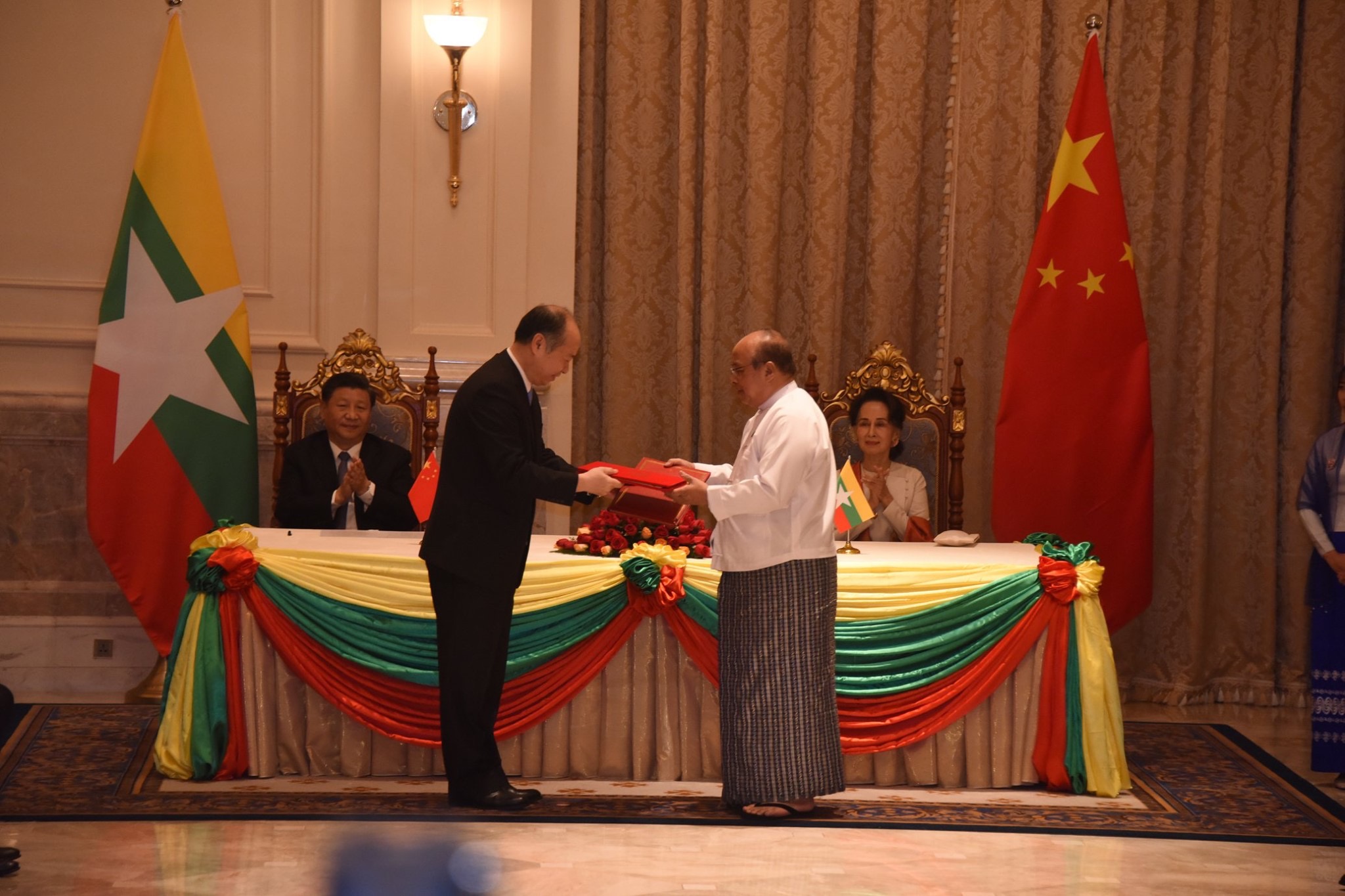YANGON—Myanmar and China signed a total of 33 memorandums of understanding (MOUs), agreements, exchange letters and protocols during Chinese President Xi Jinping’s visit to Myanmar—probably the most Myanmar has signed with its powerful neighbor at one time since 2000—enhancing bilateral relations between the two countries.
The agreements call for cooperation in sectors including infrastructure mega-project development, railways, industrial and power projects, trade, investment and human resources, among others.
The agreements were signed after Myanmar State Counselor Daw Aung San Suu Kyi and Chinese President Xi Jinping held a bilateral meeting at the Myanmar President’s Office on Saturday morning.
Xi left Myanmar on Saturday afternoon after a two-day visit.
Myanmar and China signed a concession agreement and shareholders’ agreement for the Kyaukphyu Special Economic Zone (SEZ) deep seaport project, which will boost China’s presence in the Indian Ocean. The development of the SEZ is part of Beijing’s wider plan to expand its footprint in South Asia, which has seen it invest heavily in Indian Ocean ports through its Belt and Road Initiative (BRI).
Granting China direct access to the Indian Ocean and allowing its oil imports to bypass the Strait of Malacca, the Kyaukphyu port is a crucial component of the China-Myanmar Economic Corridor (CMEC), which is a part of the BRI. It also serves Beijing’s goal of developing China’s land-locked Yunnan province. Located in northern Rakhine State, Kyaukphyu is a strategic hub for China, and already serves as the terminus for twin cross-border oil and gas pipelines between the two countries.
Fourteen of the MOUs aim to strengthen collaboration in the infrastructure sector to promote production capacity and investment cooperation by, among other things, accelerating negotiation of the framework agreement on the China-Myanmar Ruili-Muse cross-border economic cooperation zone, establishing a working group of the promotion of smooth trade, enhancing infrastructure development cooperation, conducting a feasibility study on the Myanmar-China Power Interconnection Project, establishing a Friendship-Province/Region Relationship between Yunnan Province and Yangon Region, establishing local cooperation under the framework of jointly implementing the CMEC between Yunnan Province and Mandalay Region, and working on feasibility studies for the Yangon River Estuary West Bank Protection, Mandalay-Bagan Railway Line and Watalone Tunnel projects.
As a part of the BRI, a 2017 agreement to construct three border economic cooperation zones in Shan and Kachin states was one of the first agreements the National League for Democracy government signed with China. Later, the two sides agreed to implement the Ruili-Muse cross-border economic cooperation zone first.

The two sides signed seven exchange letters covering the provision of six patrol boats for the Myanmar Police Force, a feasibility study on a three-year development plan for border areas, an agriculture product quality control center, a hybrid-rice research center, a feasibility study on a resettlement project for internally displaced persons in Kachin State, a new urban development in Yangon city and the acceleration of the Meel-lin-gyaing Integrated LNG power project.
China and Myanmar also agreed on an interest-free loan to help Myanmar procure 28 passenger coaches, cooperation between the National Radio and Television Administration of China and the Ministry of Information of Myanmar, aid in upgrading industrial training facilities in Mandalay and mutual provision of embassy lands and buildings.
During the ceremony, China again handed over to Myanmar the Muse-Mandalay Railway Feasibility Study Report, which is an initial phase of the strategic railway link that Beijing plans to build—with a parallel expressway—from Kunming to Kyaukphyu, in addition to a separate road running through northern Myanmar, India’s northeastern states and Bangladesh under the Bangladesh-China-India-Myanmar Economic Corridor (BCIM-EC).
Under the NLD government, Myanma Railways in October 2019 signed an MOU with China Railway Eryuan Engineering Group (CREEG) (formerly the China Railway Group Ltd.) to carry out a feasibility study for a standard-gauge railway from Muse, in northern Shan State, to Mandalay in central Myanmar. China handed over a feasibility report on the Muse-Mandalay Railway project to Myanmar during the second Belt and Road Forum held in Beijing in late April 2019.
In terms of the number of agreements, Saturday’s ceremony dwarfed one held in 2004 when then Chinese Vice Premier Wu Yi and Myanmar officials signed 21 agreements and MOUs on economic and technological cooperation. When Xi first visited the country in 2009 as vice president, the countries inked 16 MOUs on technical cooperation, the implementation of hydropower projects, the China-Myanmar Oil and Gas twin pipeline project and the Kyaukphyu SEZ.
Xi arrived in Naypyitaw on Friday, becoming the first Chinese president to visit China’s southern Asian neighbor in nearly two decades. It was also his first overseas trip this year.
The trip demonstrates Beijing’s eagerness to seek Myanmar leaders’ support for its ambitious BRI infrastructure projects in the country and finalize a deal on the development of the Kyaukphyu port.
In an op-ed published under his name in Myanmar’s state-owned newspapers on Thursday, Xi said he looked forward to renewing China’s “pauk-phaw” (fraternal) ties with Myanmar and discussing future cooperation during his visit. He acknowledged that Myanmar is an important partner country in the BRI.
Daw Khin Khin Kyaw Kyee, head of the China desk at the Institute of Strategy and Policy (ISP)-Myanmar, told The Irrawaddy that the majority of MOUs and agreements signed on Saturday aimed to secure firm commitments from Myanmar on the existing BRI projects, with a focus on economic-related sectors, and did not involve new agreements.
“In the past, the agreements with China were mostly aimed at natural resources exploitation. This time, the agreements cover all the economic-related sectors but I don’t see any natural resources exploitation projects,” she said.
On Friday, Xi joined Myanmar President U Win Myint and State Counselor Daw Aung San Suu Kyi at a ceremony to mark the 70th anniversary of diplomatic relations and launch the Myanmar-China Bilateral Cultural and Tourism Year, as 2020 has been designated.

At the ceremony, Daw Aung San Suu Kyi said, “In the present, we have been doing our best, practically carrying out collaborations between the two countries, including the China-Myanmar Economic Corridor Project, and other pragmatic cooperation as outlined in your BRI—Belt and Road Initiative.”
She added, “Besides, in implementing these projects, it is very necessary to be in line with the prioritized strategic national development plans of the two countries, to take measures against the damage of the environmental degradation, and to consider the development and contribution of the social life of the people.”
The State Counselor stressed that, “I truly believe that Your Excellency shares the same views.”
Myanmar signed an MOU with China establishing the CMEC in September 2018. The estimated 1,700-kilometer-long, Y-shaped corridor will connect Kunming, the capital of China’s Yunnan province, to Myanmar’s major economic centers—first to Mandalay in central Myanmar, and then south to Yangon and west to the Kyaukphyu SEZ in Rakhine State.
The CMEC is in fact the initial phase of the BRI’s Bangladesh-China-India-Myanmar (BCIM) Economic Corridor connecting Yunnan and the Bay of Bengal.
In Myanmar, the CMEC backbone projects, particularly the Kyaukphyu SEZ and Muse-Mandalay railway projects, have attracted criticism from local residents in the project areas.
A day before Xi arrived, a Kyaukphyu SEZ watchdog group urged the Myanmar government not to sign any more agreements during Xi’s visit if it could not ensure citizens’ rights and address public concerns over land confiscations in the project area. The watchdog also asked to be allowed to participate in the project’s Strategic Impact Assessment (SIA). The SIA was recommended in a report issued by the late Kofi Annan’s Rakhine Advisory Commission.
The watchdogs and local people along the railway have criticized the project’s lack of transparency and the fact that residents have not been fully consulted on its environmental impacts.
A few hours before Xi’s arrival on Friday, a prominent Shan political party issued a statement calling on the Chinese and Myanmar governments to seek approval from both local people and the Shan State parliament before implementing the China-backed cross-border economic cooperation projects in the state. The projects are part of the Chinese president’s ambitious infrastructure plans for the region.
The Shan Nationalities League for Democracy warned that the China-backed projects would have a negative impact and disturb the stability and peace in those areas if they failed to respect human rights and dignity, lacked transparency and harmed the environment and society.
Ethnic affairs and China analyst U Maung Maung Soe said that on Saturday the Myanmar government signed MOUs for the projects that China has long been pushing for.
“As far as I’m concerned, since they are still MOUs, there are a lot of steps before they reach the implementation stage. MOUs are nonbinding. So, there are no legal obligations; the agreements can be changed at any time,” he said.
During his visit, Xi held meetings with President U Win Myint, State Counselor Daw Aung San Suu Kyi, military commander-in-chief Senior General Min Aung Hlaing and leaders of the Myanmar Parliament.
You may also like tese stories:
Beyond the Cliché of ‘Pauk-Phaw’, China and Myanmar Need Each Other
Myanmar Activists Refused Yangon Embassy Protest During Xi Visit
Chinese President Xi Jinping Arrives in Myanmar for Two-Day Visit

















